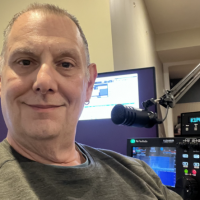Welcome to the FlexRadio Community! Please review the new Community Rules and other important new Community information on the Message Board.
Need the latest SmartSDR or 4O3A Genius Product Software?
SmartSDR v4.1.3 | SmartSDR v4.1.3 Release Notes
SmartSDR v3.10.15 | SmartSDR v3.10.15 Release Notes
The latest 4O3A Genius Product Software and Firmware
SmartSDR v4.1.3 | SmartSDR v4.1.3 Release Notes
SmartSDR v3.10.15 | SmartSDR v3.10.15 Release Notes
The latest 4O3A Genius Product Software and Firmware
If you are having a problem, please refer to the product documentation or check the Help Center for known solutions.
Need technical support from FlexRadio? It's as simple as Creating a HelpDesk ticket.
Need technical support from FlexRadio? It's as simple as Creating a HelpDesk ticket.
Microphone Recommendation

Al Reeves
Member ✭✭
I recently purchased a Flex 6300 and I'm looking for recommendations from others as to the best microphone to use. I have tried the Heil PR-40 but have had mixed reports. I have had a few folks tell me that the Heil PR-781 was the way to go. Would like more input so your responses would be most helpful.
TNX and 73
Al
W1JHU
TNX and 73
Al
W1JHU
0
Answers
-
Al I have used the PR-781 with the Flex 6300 (with the on board EQ) and received excellent reports. Currently I use the RE-20 connected to a Symetrix 528E for voice processing. I have been very pleased with the results...
73
Ronald
0 -
I have used a Logitech $20 headset with an iPad, a Koss $30 headset, a Heil Pro 6 headset, a Heil GM-5, and a Heil 781. Once the eq and gain were setup for my voice, I received unsolicited compliments on my audio using any of these mic's. I have done on-air tests, switching mic's and asking for opinions on quality differences. I have not found much difference on SSB. Received audio quality has numerous variables--the microphone is just one variable. The Flex, with EQ and gain set properly, produces good SSB audio with most microphones.3
-
The Heil PR 781 is a good choice Al... direct into the Flex, using the Flex equalization controls.
Gerd, W2ISB
1 -
I have been using a Shure PG-48 for 2 years. After following Ken NM9P EQ instructions get good reports. I used this into the balanced input with VOX or PTT as needed. Cost less than $50.00.
1 -
If you already have a PR-40, I would see no advantage in moving to a PR-781. What is needed is some time spent perfecting your Mic Profiles - gain level, filter passband, PROC and TX EQ, etc. The Default Profiles for any of the Microphones is only a starting place. Check out my tutorials on transmit audio on YouTube. YouTube.com/NM9P A little work with these controls will be rewarded immensely . Ken - NM9P3
-
I have the 6300 and running PR-781 with the W2IHY EQ and EQplus. Good reports. But I'm going to replace mic with RE-27. Jay W0JAY0
-
I use an Electro Voice RE27N/D with my 6700 and when properly setup, get excellent audio reports.
0 -
Al, asking someone what Mic you should use would be like asking one of us to pick you out a pair of shoes. Everyone has different taste and preferences. Yes there are standards which you have already mentioned but a mic is extremely dependent on YOUR voice and its characteristics. This is where EQ settings come into play to tailor the shape to your voice and the type of audio you are looking to achieve. Some hams like 2.4khz punchy some prefer full spectrum 3.3khz audio.
I would say the hardest part of setting up the audio on almost any radio is the EQ settings, not the mic. (assuming you start with a decent mic). Unfortunately it takes a lot of testing and tweaking which can be frustrating.
My suggestion is to try to adjust the EQ the best you can to your own ear by listening to your own signal, then get multiple reviews from someone you trust. One CAUTION... find out what radio and speaker system the person is using to give you feedback. If the feedback is from someone with a narrow passband and computer speakers then that is not a valid reference. And finally remember most radios have Receive EQ so depending on how I like my receive EQ can effect the report you get.
The nice feature of the FLex is you can save multiple mic profiles and try different settings and ideas.
Hang in there and keep at it.
Lee1 -
Lee speaks the truth. Microphones are like toothbrushes, very personal. That being said, I have been using the PR781 for years, with my 6300 and before that my 5000 and 3000. They question you should ask is why not use the PR781. After all, there are already presets for it built into the software. It's long proven with many, many operators using it for Flex, and the price is reasonable compared to some of the microphones in that class.0
-
Ken is absolutely right. The PR-40 can be "profiled" from ESSB to hardcore
dx communication. The real limiting factor in many situations for any of these
microphones is the audio system (including ears) on the other end. Do as Ken
suggests and you will be well-rewarded for the effort. You will be able to set up
a group of configurations suitable for whatever type of operation you might like.
The PR-40 is great. You can make it sound like a PR-781 if that's what you want.
Keep at it,
Ned, K1NJ
0 -
Ken hit it right on, you already have the PR-40 which is a step up from the PR-781. How a microphone sounds is very difficult to judge by a report. So many factors can affect the report like band conditions and who is giving you the report, the equipment and settings of the listening station, is it the same person, your shack conditions, levels, bandwidth, EQ, position/distance from the microphone just to name a few. To tell subtle differences of microphones and settings requires someone with a good ear for audio and a lot of patience. Listening on the bands I've heard many reports of guys telling their buddies they sound good when they really don't, but it's good enough for them. It depends on what the definition of "good" is.
The fact that someone gave you a better report on the PR-781 vs the PR-40 surely means you did not have the EQ or other things optimized for the PR-40, or something other variable changed when you swapped out microphones.
I've set higher audio standards for myself as are a lot of hams these days. We've got an elite radio, why not input better audio to our radios? My PR-40 goes through a tube pre-amp to help smooth out my voice. Speaking of Ken, NM9P, he has some great tutorial videos which will assist you setting up your SmartSDR microphone and profiles for various operating conditions. I've got them linked on my QRZ page but for convenience here they are:0 -
Ken:
I watched the video to set profiles using FDX feature. The TX audio I hear is echoed with a slight delay. I di mute the TX slice speaker. What am I doing wrong?
Al
W1JHU
0 -
The delay you hear is the combined processing delay of the transmitter audio chain and the receiver audio chain. You do not use MON for this setup, or you will hear your voice twice. The slight delay takes a little to get used to. But it is very handy to hear the actual differences made as you adjust different parameters. Just be sure that your receive channel filter is wider than your transmit filter and that your RX EQ is off, or you will not hear exactly what your transmitter is sending.0
-
PR 40 and adjust the equalizer properly and you have almost broadcast quality.
I use this setup and find it superior in it's voice articulation .
Ian
0 -
Ken:
Did some more settings. Slice A on XVTR with speaker muted and set to TX on 7160. Slice B on ANT 1 with speaker unmuted and set to RX on 7163. MON off. Activated MOX and can see audio profile on both Panadapter displays but cannot hear any audio from Slice B. What am I doing wrong?
Al
W1JHU
0 -
Jay:
Do you do all the EQing with the W2IHY gear and set the Flex TX EQ to flat 0db? Or do you do further EQing with the Flex EQ?
Al
W1JHU
0 -
I thought I'd jump into this discussion. I have a PR40. It is a great mic, but a little expensive. It does suffer from the proximity effect more than other mics I have, so I use a windscreen and talk right up on it so that I am always the same distance away from the mic. Since it has a wide frequency response, you do have to properly adjust the bass EQ settings (cutting, not boosting for most male voices). I also find that the output on this mic is a little low, so I use an external mic preamp and feed the output into the balanced line in on my 6700. For a 6300, you would use the front mic connector and the internal +20 dB mic preamp in the radio.
I used the default PR781 mic profile as a starting point for the EQ settings and then adjusted it to my voice by listening to my transmitted signal with a FLEX-5000 with the filters wide open to set the EQ and then backed the RX filter back down to 2.9k to tweak the TX EQ. You can also record your post-processed audio and play it back (see the SmartSDR Software User's Guide) or have another FLEX owner record you off the air and play it back to set your EQ too (it helps if the op knows what your voice sounds like normally) to set your EQ settings. Then save your settings with a new mic profile.
I use a variety of other mics from time to time, like a Shure SM58 (40 years old, beat to heck and still one of the best vocal mics I have ever owned) and a variety of large diaphragm condenser mics and some cheap dynamic vocal and instrument mics with good success. I have used an RE27 too. It is a fantastic broadcast mic, but it is really expensive. I wish I owned one. The key takeaway here is that you do not need an expensive mic to make a FLEX-6000 sound great. If the mic has a wide frequency response and covers the low end well, you can match it up with a FLEX-6000 and make it sound great. But it takes a little work to match it up using the EQ.
It really helps to have a fundamental understanding of how best to use an EQ and what effect boosting or cutting will have at specific frequencies in relationship to a male voice. There is a good article in the HelpDesk for this: https://helpdesk.flexradio.com/hc/en-us/articles/203853305-Rules-for-EQing-Voice-for-Optimal-Phone-O...
I can't stress too much following the rules for cutting before boosting. An EQ is not going to provide vocal content and characteristics that are not already present in your voice. An EQ is not a miracle worker. What it will do is allow for you to "match" a mic and AF audio chain to your voice to make your audio more intelligible (sound like yourself).
Work on that PR40 and I guarantee you will have great results.2 -
Set slice b to same frequency, same mode. Make sure that Both slices have the red (TX) ant selector set to XVTR and the blue (RX) ant selector to ANT1. Make sure the FDX is activated by clicking on FDX on the bottom bar. (Where CWX, TNF are). Double check that you haven't accidentally muted the main speaker or headphones, or the receive slice .0
-
Right on point, Tim. And the article you posted is excellent. I use a Heil PR22UT, which was about $106 about the same as a SM58 in price. And I get great audio reports. I would love to have a PR781 or PR40, mostly for the off-axis noise rejection, but they are priced out of my budget. I have heard a lot of both models, and also the RE's, and most of them sound great. The ones that have problems are the ones that have the low-cut set too low, or especially those who do not realize just how much bass response the PR40 has and boost it even more. With a "full range" mic, I always begin by cutting several sliders on the low end, sometimes rather dramatically, before I ever get to boosting the high frequencies. The 6000's tx EQ, filters, and processor can make a good mike sound great, and a great mic sound wonderful. But a badly adjusted SDR can make even a wonderful mic sound very bad.0
-
I use several of the already named microphones. For my voice the Sennheiser 835 s gives best on air reaction. It's very punchy but has a warm, natural sound and best of all, it's not that expensive. Compared with other mics it has consistent sound quality when varying distance or move off axis. Enjoy your new radio, you'll find the best microphone for your voice. 73 de Manfred0
-
I would echo Ken's suggestion. I have a Heil Gold Elite with my Flex 6300 and was not getting many great comments (not a lot of bad comments either ). Then I spent some time learning how to tailor the audio and listen to it back. Then I started to get unsolicited positive comments on the HF bands.0
-
I had the PR781 and sold it and purchased the RE27ND.
Love the mic and have excellent reports on my audio.
This will be the last mic I will ever need.
Mic gain 40
Proc DX+
63-10
125-10
250+2
500-5
1k0
2k+8
4k+8
8k0
I do the Wolverine ssb net on Monday nights. 3.935
Work 40 or 20 meters when ever.
But I love 160 and I'm on 1.970 1.940 1.930 and 1.850 at night.
If anyone wants a qso give me a time and a band/freq.
VA3KBC
DJ1 -
I haven't used one, but by the spec numbers, response graph, and reviews, it looks very nice for the price.
Ken - NM9P0 -
The Sennheiser 835 has a slight high-frequency emphasis starting at 2500Hz and peaking at 4500 Hz. This will provide an accentuation of the human voice making it a good mic for radio work.1
-
I have used my FLEX-6500, mic RODE Broadcaster + Universal Audio LA-610 MkII
0 -
I have a PR-40 running VERY well with my 6300, see my website and go under audio profiles to see the settiings I am using with GREAT results! www.3895khz.com0
-
That is one KILLER setup. Really nice choices of gear. The UA is warm... the Rode is accurate, has a low cut switch, and has a built-in filter for plosives. You could pay a lot more and not get that much nicer gear. Nobody on ham radio NEEDS a mic and channel **** like this.... but your ham hobby sure can give you an excuse to buy it. I can see this as great for a rag chew,,, but I wonder how if it can be adjusted to punch through for DX type work? Thanks for sharing, Peter K1PGV0
-
Hello, Peter!
Thanks!
The call of DX, doesn't represent problems.
For my voice:
MIC RODE Broadcaster:
HPF 70Hz On
LA-610 MkII:
Gain: -10
Mic: 500
Level: 6.5
EQ:
High 4.5 (0)
Low 70Hz (-3)
Mode: Comp
Meter: GR
Peak Reduction: 7
Gain: 7
FLEX-6500
Line (40)
DEXP (50)
PROC (NOR or DX)
EQ
63 (-4)
125 (+1)
250 (-6)
500 (-3)
1K (-1)
2K (+1)
4K (+5)
8K (-5)
BW TX: 50Hz ~ 3000Hz
Flat Response: 80Hz ~ 3000Hz
73!0 -
Ken, The you tube videos are a great help, thanks for taking the time to make them. Have you ever tried your procedure using a mic and headphones connected to a PC (i.e. using Opus). I gave it a try but there is an echo and a great deal of some sort of noise. If I turn down the mic gain the noise goes away (along with the voice of course). I can’t figure out what is causing the noise and the echo.0
-
I have successfully used it via Smart Link remote on my office desktop and a computer headset mic. Also via lan WiFi on my laptop at home. The DownwardExpander (DEXP) doesn’t work via remote/PC Mic input, so that may allow more noise. I’m not sure whether the noise you are hearing is from too high RF gain on your monitoring slice, or two high Mic gain. I have noticed that I need to be extra careful not to drive the mic too hard when in remote mode or when using PC Mic input. And make sure you aren’t getting the mic playing back through the computer speaker/headphones via the sound card interface, and not just the Flex Radio receiver. Also, make sure your PC internal settings aren’t doing any unexpected processing before it goes to the rig. You will definitely have more latency via the pc and or remote setup. This may also make it sound like more echo. Good luck. Ken - NM9P1
Leave a Comment
Categories
- All Categories
- 381 Community Topics
- 2.1K New Ideas
- 633 The Flea Market
- 8.3K Software
- 131 SmartSDR+
- 6.4K SmartSDR for Windows
- 185 SmartSDR for Maestro and M models
- 430 SmartSDR for Mac
- 272 SmartSDR for iOS
- 259 SmartSDR CAT
- 197 DAX
- 382 SmartSDR API
- 9.4K Radios and Accessories
- 42 Aurora
- 265 FLEX-8000 Signature Series
- 7.2K FLEX-6000 Signature Series
- 955 Maestro
- 56 FlexControl
- 866 FLEX Series (Legacy) Radios
- 929 Genius Products
- 464 Power Genius XL Amplifier
- 340 Tuner Genius XL
- 125 Antenna Genius
- 297 Shack Infrastructure
- 209 Networking
- 461 Remote Operation (SmartLink)
- 144 Contesting
- 788 Peripherals & Station Integration
- 140 Amateur Radio Interests
- 1K Third-Party Software





